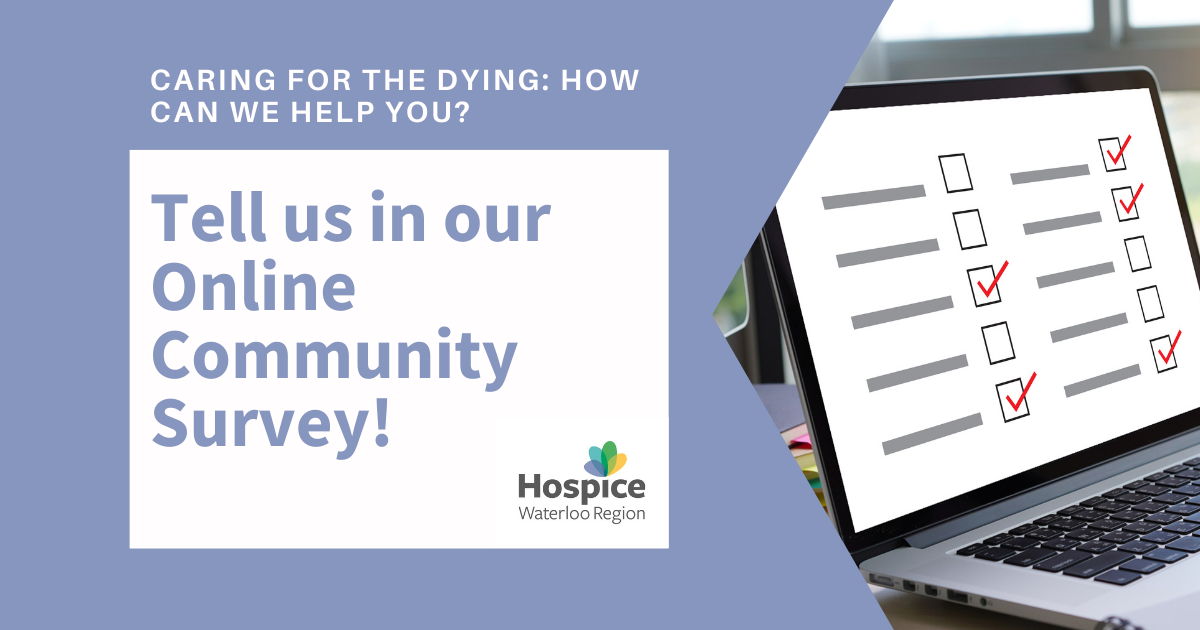Caring For the Dying: How Can We Help You?

For over 26 years, Hospice of Waterloo Region has been a community outreach hospice focused on working with community volunteers to support those who are dying and experiencing loss.
Our success in launching a 3-year Advance Care Planning Project in 2015 reinforced the value of working with the community to raise awareness, educate and build capacity so that we, as a community, support our family, friends, neighbours and colleagues with death, dying and grief. However, for a number of reasons we remain a death denying culture. As an organization, our greatest challenge is to find ways to engage community in conversation so that we can build that knowledge and capacity to support each other.
We are developing a new initiative and encourage you to read our blog “Caring for the Dying – the 95 per cent rule” as we seek public’s feedback through a short survey (link below). It seems that WE, as a community, struggle to know what to say or what to do to help someone who is dying or grieving a death.
HWR is seeking your feedback on the kind of information that would help YOU better support someone. Please help us by completing this short survey by Nov. 20, 2020.
Caring For The Dying — The 95% Rule
A personal message from Sheli O’Connor, the Director of Community Engagement and Partnerships.
After 30 years in community work for older adults, I joined Hospice of Waterloo Region to lead a community outreach project focused on Advance Care Planning Working at HWR. Going out into the community to talk about sharing one’s wishes for future health care landed me smack in the middle of the death denying culture where talking about death or even preparing for death was NOT something people readily embraced. I saw it in the reluctance to have these important conversations, the wide path the public took to avoid my info booth and sadly in the late referrals or the “I only wish I’d known “statements made by grieving families and friends.
Dr Kathryn Mannix, a leading palliative care physician in the United Kingdom, suggests that death denial is a result of the “kidnapping of death” by the health care system back in the early 1940’s. The kidnapping she is referring to is the surprisingly quick shift of care and responsibility for the dying that we inadvertently accepted as a result of medical innovation/ advancements that focused on cure.
No one could have foreseen that this shift would mean that fewer and fewer of us had the direct experience and comfort with death and dying of previous generations. Instead of shared responsibility, it became more and more acceptable to let go and allow health professionals and hospitals to carry that responsibility. I am not suggesting that care is an either or, and I am not suggesting that we intentionally gave up. But somewhere along the way we lost the confidence in our own ability to provide care to the very ill and dying and it’s time to get it back.
Dr Allan Kellehear, founder of the Compassionate Community movement suggests that when we are dying and /or grieving 95 per cent of our time is spent with family, friends, colleagues, and neighbours (including our pets and online communities). In doing the math, it feels like an “aha” moment as we realize that those that are dying are spending only about 5% of their time in front of a health care professional. Dr Kellehear asks the question: what are WE doing with that 95%?
My take is that the dying and grieving are part of US and they need US. But how does that happen if we don’t want to talk about the d-word? If we avoid the grieving friend in the grocery aisle or if we promise to visit and never do because we just don’t know what to say or how to help? Please don’t think I am blaming or judging anyone as I too have struggled with the very situations I have described and most often it has been my own lack of experience and the greater fear of doing or saying the wrong thing that has held me back.
Author Caroline Doughty, in her book “If there’s Anything I can Do“ has captured that “lost way” in the following:
….there have been times when people haven’t known what to say or do and when even the closest of friendships have strained at the seams; when I walked back into work and a silence fell as people looked down at their desks, unaware of how to treat me; when mothers from the nursery dodged into another aisle in Sainsbury’s to avoid me; when I realised that friends had stopped calling because listening to my unending pain was just becoming too much.
So what are we going to do in that 95 per cent? I admit to being a huge advocate for shared responsibility and the essential role of the community in caring for each other. You need look no further than the incredible commitment, passion and innovation of the 200+ Hospice volunteers to see what the public can do.
We are all connected to others in our families of choice, our friends, our colleagues and our neighbours. Truly that area of 95 per cent is US. There is no doubt that since that “death kidnapping” suggested by Dr Mannix, we have less experience, knowledge and comfort with death, dying and grief. However, in our humanness, few, if any, can say that they have not been touched by death or grief.
So back to Dr Allan Kellehear and his 95 per cent rule; I think it’s a great number to keep in one’s head. He has made a few great statements to guide us and I want to leave you with this one:
…care for one another at times of crisis and loss is not simply a task solely for health and social services but is everyone’s business.”
